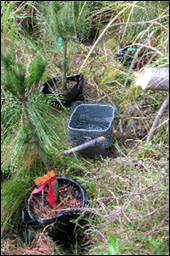PESTS AND DISEASES OF FORESTRY IN NEW ZEALAND
Red Needle Cast update, March 2017
Scion is the leading provider of forest-related knowledge in New Zealand
Formerly known as the Forest Research Institute, Scion has been a leader in research relating to forest health for over 50 years. The Rotorua-based Crown Research Institute continues to provide science that will protect all forests from damage caused by insect pests, pathogens and weeds. The information presented below arises from these research activities.
From Forest Health News 271, March 2017.
A severe outbreak of red needle cast (RNC) in some Pinus radiata forests in the central and eastern North Island during the latter half of 2016 is an example of the unpredictable and uneven nature of this disease. Our research on RNC continues to focus on predicting when disease outbreaks will occur, as well as identifying resistant P. radiata genotypes and developing effective chemical control methods. We reported on our prediction work in FH News 268 (August 2016). Here we feature our progress over the last six months, most notably on our work investigating the weather and environmental conditions that may trigger outbreaks, and possibilities for chemical control.
We have begun longer-term monitoring of the extent and severity of RNC to better understand how weather conditions and seasonal changes initiate outbreaks. This work started in 2016 and uses 50 survey points in the central and eastern North Island. Monitoring will continue for a number of years. The aim of the work is to build complementary data sets of disease prevalence and weather conditions which will be used to develop a predictive model.
We have also been conducting studies to determine the infection period of the causal agent of RNC, Phytophthora pluvialis. Young, potted P. radiata plants placed near older stands with RNC (a source of inoculum) were successively exchanged for fresh sets of plants at fortnightly intervals. Traps using floating pine needles as baits were also positioned at the same locations to determine when spores of P. pluvialis were released (Picture).

Findings from this study have been promising. We determined that young plants became infected from July through to October, while P. pluvialis was recovered from spore trap baits in October. Results indicate that more plants and traps will be needed in future studies. The appearance of sporangia on exchange plants suggests that the pathogen is capable of more than one infection cycle during a season, which helps to explain the rapid increase in disease levels seen in some years. Maximum disease expression occurred during late winter and spring and then gradually declined over summer as affected needles were cast and replaced by the new flush of needles. This resulted in trees that appear generally healthy and green, but with a low crown density.
The prolonged period in which infection occurs highlights the need for a control method that can persist for at least four months. We have conducted a number of chemical control trials over the past two years and have made progress assessing the efficacy of the active ingredients cuprous oxide and phosphite. These chemicals were applied to young plants growing in pots in three studies, and in a large scale field trial they were applied aerially.
The pot trials showed promising results. Needles taken from plants treated with either copper or one phosphite treatment developed fewer and smaller lesions than untreated needles after inoculation with P. pluvialis. In one of these studies, copper showed effective disease suppression for up to six months following treatment, while copper and phosphite applied together did not result in increased disease control. Results from the field trial have supported those observed in the pot trials. Copper suppressed disease development three months after the initial application in February 2016, but after nine months no treatment effects could be demonstrated.
This information is intended for general interest only. It is not intended to be a substitute for specific specialist advice on any matter and should not be relied on for that purpose. Scion will not be liable for any direct, indirect, incidental, special, consequential or exemplary damages, loss of profits, or any other intangible losses that result from using the information provided on this site.
(Scion is the trading name of the New Zealand Forest Research Institute Limited.)

 Farm Forestry New Zealand
Farm Forestry New Zealand

